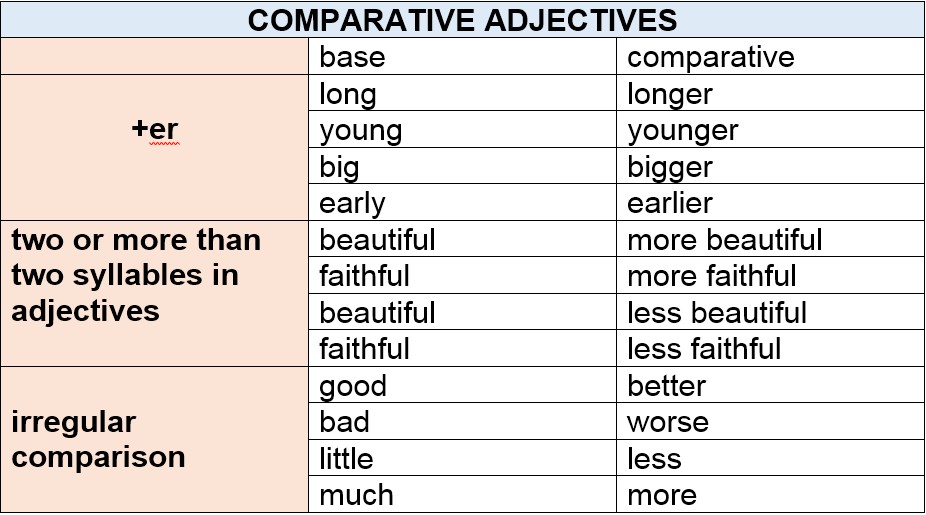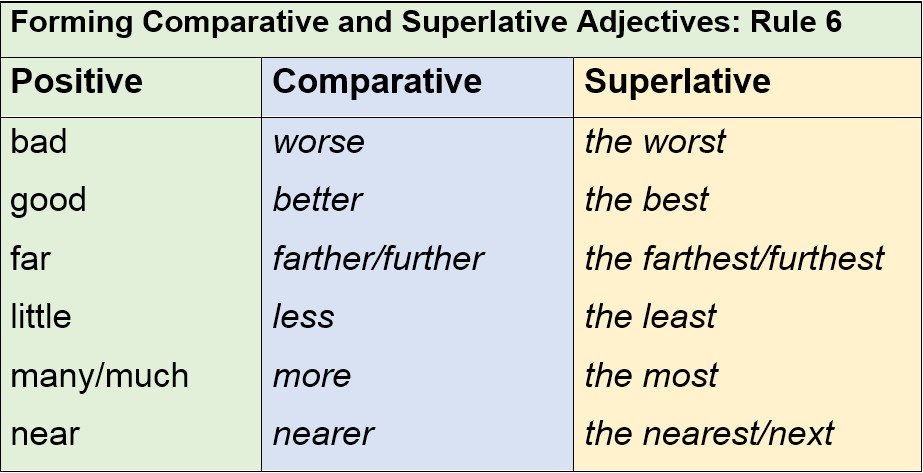Download
Basic English Grammar Book for Students PDF File
DEFINITION: An adjective is a part of speech which describes, identifies, or quantifies a noun or a pronoun.
Types of Adjectives:
Based on how they are used adjectives can generally be classified into
Attributive adjectives are part of the noun phrase followed by the noun they modify. They always come before the noun or noun phrase they modify
EXAMPLE:
happy people
funny story
2. Predicative adjectives
Predicative adjectives are linked via a copula (linking verb) to the noun or pronoun they modify.
Predicative adjectives are adjectives which follow a linking verb and describe the subject. Predicative adjective does not act as a part of the noun it modifies but serves as a complement of a linking verb.
EXAMPLE:
They are happy.
It is funny.
The weather is cool and dry.
The movie seems interesting.
The girl is beautiful.
Other types of adjectives are:
- Descriptive Adjectives
- Adjectives of Quantity
- Possessive Adjectives
- Demonstrative Adjectives
- Interrogative Adjectives
- Personal Titles
There are three degrees or levels of adjectives, that is, degrees of comparison: positive, comparative, and superlative. When we talk about or describe only one single person, place, or thing, we use the positive degree. The positive form is the base form of the adjective. The following degrees of comparison will be explained in details:
- Comparative Adjectives
- Superlative Adjectives
Descriptive Adjectives
Descriptive adjectives describe nouns that refer to action, state, or quality. and answer one of these questions:
Which one?
What kind?
How many?
EXAMPLE:
He is a tall man.
They are good students.
She is a beautiful girl.
Adjectives of Quantity
Adjectives of quantity show the quantity of the noun and provides answer to the question of ‘how much?’. The adjectives of quantity show the quantity or the numbers present in the sentence.
EXAMPLE:
Peter has little knowledge about the world.
Monday will be the first day of school.
Possessive Adjectives
Possessive adjectives show possession. They are similar to possessive pronouns, but they are used as adjectives which modify a noun or a noun phrase.
EXAMPLE:
Have you seen my car?
This is our house.
Demonstrative Adjectives
The demonstrative adjectives demonstrate something and are similar to demonstrative pronouns. They are this, that, these, those.
EXAMPLE:
This pencil is mine.
Those books over there are expensive.
Its skin is dry and rough.
Interrogative adjectives
Interrogative adjectives modify a noun or a noun phrase. They are similar to interrogative pronouns. Interrogative adjectives do not stand on their own. They are: which, what, who, whose, whom, and so on.
EXAMPLE:
Which snakes are poisonous?
Whose pencil is this?
Personal Titles
Personal titles are adjectives used as titles that function as adjectives to describe nouns. Personal titles are as follows: Mr., Master, Miss, Mrs., Uncle, Auntie, Lord, Dr., Prof. and so on.
EXAMPLE:
Dr. Johnson will examine her later today.
Aunt Mary and Uncle Shane are coming to visit us.
Comparative Adjectives
Comparative adjectives are used to compare two things. They imply increase or decrease of the quality or quantity of the nouns.
FORM: The suffix -er is added to the base (stem) of the adjective to form most comparatives. When a two-syllable adjective ending in -y receives -er for comparative, we get -ier
(-y+ –er = –ier)
EXAMPLE:
happy + -er = happier
pretty + -er = prettier
Adjectives with three or more syllables are preceded by the word more if we wish to emphasize increase in quality. However, if we wish to express decrease in quality, we use the word less.
EXAMPLE:
Some adjectives have irregular comparative and superlative forms. These need to be memorized.
EXAMPLE:
The Ohio River is longer than the Mississippi River.
James is taller than Peter.
Science is more important than soccer.
This sandwich is better than the one we had yesterday.
Superlative Adjectives
Superlative adjectives are adjectives that show the greatest increase or decrease of the quality in a noun. If we are to compare more than two things, the superlative form of the adjectives should be used.
FORM: We use definite article the before the superlative form of the adjective.
For the most part monosyllabic adjectives form the superlative form by adding suffix -est to the base (positive form).
EXAMPLE:
She is the smartest girl in the class. (smart – the smartest)
Steven is the youngest soccer player in his team. (young – the youngest)
However, if the adjective has two or more syllables, we use the word most before the positive form to create the superlative form of the adjective. However, if we wish to express decrease in quality with superlative, we use the the least before the positive form of the adjective.
EXAMPLE:
That must be the most/ the least foolish thing we have ever done. (foolish – the most/the least foolish)
Philip was the most / the least cheerful person on the team. (cheerful – the most/ the least cheerful)
Jennet is the most/ the least beautiful girl I have ever seen. (beautiful – the most / the least beautiful)
FORMING COMPARATIVE AND SUPERLATIVE ADJECTIVES
When we form comparative and superlative forms of adjectives, we follow 6 rules.
RULE 1: Positive (base) form of adjectives containing one syllable (monosyllabic) receive suffix -er to make a comparative form, and suffix -est to make a superlative form. Definite article the is used before the superlative form.
RULE 2: Monosyllabic positive form of adjectives ending in -e receive only -r for comparative and -st for superlative.
RULE 3: Monosyllabic positive form of an adjective that contains a short vowel between two consonants (CVC) gets its last consonant doubled before suffixes -er and -est.
RULE 4: Disyllabic (two syllables) positive form of an adjective ending in -y undergoes a spelling change after adding suffixes -er for comparative and -est for superlative. In this case -y becomes -i, thus we have: -y + -er = -ier and -y + -est = -iest.
RULE 5: Word more is used before a polysyllabic (two or more syllables) adjective to form a comparative form. Words the most are used before a polysyllabic (two or more syllables) adjective to form a superlative form.
RULE 6: Some adjectives have irregular comparative and superlative forms.
ORDER OF ADJECTIVES
Sometimes we use more than one adjective in front of a noun.
EXAMPLE:
Marry is a nice intelligent young woman.
In general, the adjective order in English is:
- Determiners — articles, possessive pronouns, demonstrative adjectives, adjectives of quantity, or …
- Observation — postdeterminers (e.g., a real hero, a perfect idiot) and adjectives subject to subjective measure, known as opinion adjectives (e.g., beautiful, interesting), or objects with a value (e.g., best, cheapest, costly)
- Size and shape — adjectives subject to objective measure (e.g., wealthy, large, round), and physical properties such as speed.
- Age — adjectives denoting age (e.g., young, old, new, ancient, six-year-old).
- Color — adjectives denoting color (e.g., red, black, pale).
- Origin — denominal adjectives denoting source of noun (e.g., French, American, Canadian).
- Material — denominal adjectives denoting what something is made of (e.g., woolen, metallic, wooden).
- Qualifier —often regarded as part of the noun (e.g., rocking chair, hunting cabin, passenger car, book cover).
When we use two or more adjectives together, opinion adjectives (e.g. interesting, beautiful) usually go before fact adjectives (e.g. new, blue).
EXAMPLE:
This is an interesting blue whale.
I do not like that ugly red dress.
When two or more fact adjectives come before a noun, they normally go in the following order:
Size + Age + Shape + Color + Origin + Material + Purpose + Noun
EXAMPLE:
Peter saw a small rubber ball. (size + origin)
An elderly German lady stood in the corner of the room. (age + origin)
He always wore white leather tennis shoes. (color + material + purpose)












